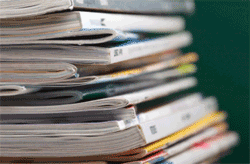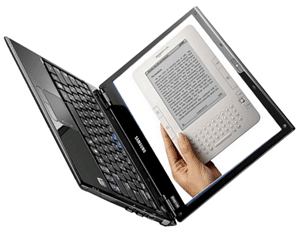 We don’t even know for sure whether Apple will ever release a tablet–although there’s lots of compelling evidence that it will–and already there’s a lively debate about whether the company is interested in using said tablet to do to printed reading materials what iTunes has done for music.
We don’t even know for sure whether Apple will ever release a tablet–although there’s lots of compelling evidence that it will–and already there’s a lively debate about whether the company is interested in using said tablet to do to printed reading materials what iTunes has done for music.
Until recently, the smart money seemed to be on Apple staying out of the e-reader fray–cue references to Steve Jobs saying that nobody reads anymore. But over at Gizmodo, Brian Lam is reporting that Apple has been in talks with publishers of textbooks, newspapers (the New York Times, specifically), and magazines–presumably as it gets ready to announce its tablet. Maybe the company is interested in catering to those of us who do read after all.
I hope so–and as a former magazine guy, I’m most interested to see what Apple might do with the medium I left behind but for which I’ll never lose my affinity. For all the things that are right with Amazon.com’s Kindle e-book reader, its treatment of magazines is pretty horrible. It may have signed deals to offer thirty-six well-known titles, but every Kindle magazine I’ve seen has been stripped of most of its formatting, graphics, and…life. There’s no particular benefit to Kindle magazines except for saving some trees and space on your coffee table, especially when far more dynamic, engaging, interesting versions of most of the same content is available for free on the Web.
And ultimately, I don’t think largely static downloadable magazines such as those offered by Amazon (as well as PDF-like print replicas such as Zinio versions) are going to revolutionize anything. We don’t need new formats for magazines that compete with the Web–we need to use Web technologies to create more compelling digital versions of traditionally pulp-based publications. An electronic version of, say, the New Yorker shouldn’t be an entirely different beast from NewYorker.com. It should be a variant that can be pushed to a device (be it from Amazon or Apple) and read even when you’re offline, with slicker type, graphics, and overall presentation than the Web currently permits. And what the heck–it should retain the wonderfully browsable, print-oriented concepts of a cover, a table, of contents, and a sequence of pages from beginning to end. (In this case, it should also involve cartoons interspersed throughout, which you can choose to read first.)
Like Web pages, these magazines should work on multiple devices from different manufacturers–if Newsweek is available in slightly different, incompatible variants for the Kindle and Apple’s tablet, it’s just going to drive everybody crazy.
Oh, and whoever solves this problem needs to figure out issues of screen orientation–one of the big gotchas with Zinio magazines is that they’re portrait-oriented publications in the mostly landscape-oriented world of computer displays.
I don’t know if Brian’s story is right on the money–and if it is, I have no idea what Apple has in mind. But I do know that even though I don’t currently subscribe to any digital magazines, I’d happily plunk down my money for ones that got the format right. So far, nothing’s come close. I’m a happy optimist, so I’m assuming this will get solved relatively soon–if not by Apple, by somebody.
 Amazon gears up for Superkindle.
Amazon gears up for Superkindle.
 Watching movies over the Internet offers instant gratification. DVDs and Blu-Ray feel more permanent, and look consistently good even if you have the world’s most sluggish network. So Amazon is offering a pretty clever combo deal:
Watching movies over the Internet offers instant gratification. DVDs and Blu-Ray feel more permanent, and look consistently good even if you have the world’s most sluggish network. So Amazon is offering a pretty clever combo deal:  [UPDATE: I tried again, and Kindle for PC is now downloading all my books swiftly and reliably. Not sure why it wasn’t before…]
[UPDATE: I tried again, and Kindle for PC is now downloading all my books swiftly and reliably. Not sure why it wasn’t before…] Today’s Windows 7 launch mostly involved stuff we already knew about, but there was a “just one more thing”:
Today’s Windows 7 launch mostly involved stuff we already knew about, but there was a “just one more thing”:  That was fast! Two weeks ago, Amazon.com
That was fast! Two weeks ago, Amazon.com  We don’t even know for sure whether Apple will ever release a tablet–although there’s lots of compelling evidence that it will–and already there’s a lively debate about whether the company is interested in using said tablet to do to printed reading materials what iTunes has done for music.
We don’t even know for sure whether Apple will ever release a tablet–although there’s lots of compelling evidence that it will–and already there’s a lively debate about whether the company is interested in using said tablet to do to printed reading materials what iTunes has done for music.